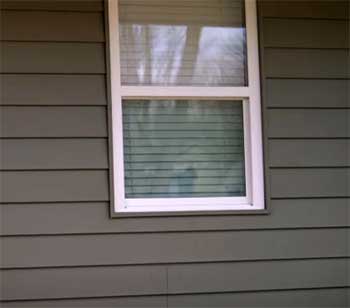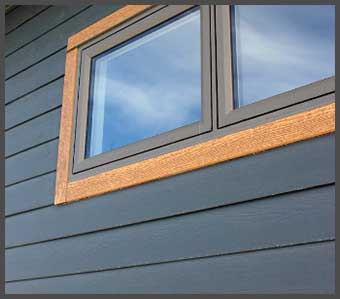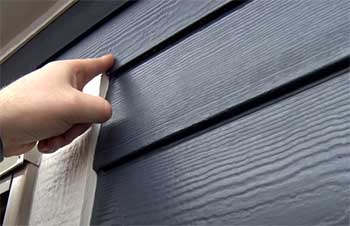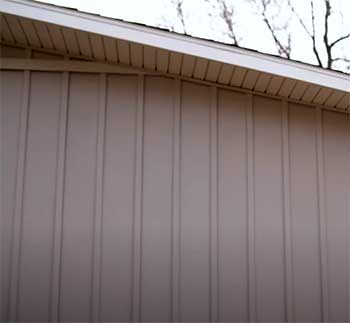When it comes to siding options for your home, CraneBoard and Hardie board (also known as HardiePlank) are two of the most popular choices on the market today.
Both offer durability, longevity, and resistance against rot, fires, termites and more.
But there are some key differences between CraneBoard siding and Hardie board that are important to consider when deciding which is the best option for your home.
A Brief Comparison Table
| Factor | CraneBoard | HardiePlank |
| Warranty | Good | Better |
| Insulation Value (R-value) | 1.25 | 0.7 |
| Fire Rating | Class A | Class A |
| Durability | 30+ years | 30+ years |
| Maintenance | Low | Low |
| Availability | Good | Better |
| Design Flexibility | High | High |
| Resistance to Damage | Excellent | Excellent |
| Ease of Installation | Moderate | Moderate |
Overview of CraneBoard Siding
CraneBoard is a fiber cement siding product created by Nichiha. It consists of sand, cement, cellulose fiber, and other proprietary ingredients that are mixed and cured into boards under extreme heat and pressure.
Some of the key benefits of CraneBoard siding include:

- Durability – CraneBoard siding is highly durable and impact resistant. The fiber cement material does not rot, warp, or dent easily. It stands up well to hail, high winds, and other weather extremes.
- Fire resistance – CraneBoard has a Class A fire rating, the highest possible for exterior cladding. This makes it very fire resistant.
- Termite and pest resistance – The dense fiber cement material deters termites, ants, and other pests.
- Low maintenance – CraneBoard siding requires very little maintenance compared to many other sidings. Occasional cleaning and repainting is all that is needed.
- Long lifespan – With proper installation and care, CraneBoard siding can last 50 years or more. This longevity makes it a great value.
- Energy efficiency – CraneBoard provides an R-value of R1.25. This helps insulate your home for improved energy savings.
- Custom looks – CraneBoard siding comes in a variety of styles and finishes to create different aesthetic looks. Smooth, wood grain, and stucco finishes are available.
Overview of Hardie Board Siding
Hardie board, also referred to as HardiePlank, is a popular brand of fiber cement siding produced by James Hardie. Like CraneBoard, it is made from a mixture of cement, sand, and cellulose fibers.
Here are some of the notable benefits of Hardie board siding:

- Fire resistance – Hardie board has a Class A fire rating and does not combust or feed fires. This adds safety and security.
- Impact resistance – The rigid boards stand up well to hail, falling branches, and other impacts. They are crack and dent resistant.
- Pest resistance – Hardie board resists damage from termites and other pests that can destroy wood siding options.
- Durability – With a lifespan of over 30 years, Hardie board siding holds up well in all weather conditions without rotting, warping, or delaminating.
- Low maintenance – Little maintenance is needed beyond occasional repainting or cleaning.
- Warranty – Hardie board comes with a 10 year limited product warranty and a 30 year limited transferable warranty.
- Appearance – The siding comes in various colors, textures, and looks to achieve different aesthetics.
Comparing the Pros and Cons
Now that we’ve reviewed some of the major benefits of each siding option, let’s directly compare some of the pros and cons of CraneBoard vs Hardie board:
Durability
- CraneBoard offers exceptional durability that matches or exceeds Hardie board. Both are resistant to rot, impact, pests, and moisture damage.
Fire Resistance
- Both CraneBoard and Hardie board share Class A fire ratings for superior fire safety. This is a wash.
Maintenance
- Very little maintenance is required for either option. Low maintenance is a pro shared by both CraneBoard and HardiePlank.
Warranty
- Hardie board offers longer warranties of 10 years for the product and 30 years transferable. CraneBoard’s warranties are not quite as robust.
Appearance
- Lots of design flexibility and similar aesthetics. CraneBoard offers smooth, wood grain, and stucco finishes while HardiePlank offers smooth, wood, and rough finishes. Draw.
Insulation Value
- CraneBoard provides a higher R-value of R1.25 compared to Hardie board’s R0.7. This gives CraneBoard better insulating properties.
Price
- CraneBoard is generally 15-20% cheaper than comparable HardiePlank products. Cost savings is a win for CraneBoard.
Availability
- While both are widely available, HardiePlank may have an edge with broader distribution across major home improvement stores.
Longevity
- With both lasting 30+ years when properly installed, longevity is a wash.
Looking at these pros and cons, a few differences stand out:
- Insulation – CraneBoard’s higher R-value provides better thermal efficiency. This can reduce energy costs.
- Price – The cost savings of CraneBoard makes it more budget friendly.
- Warranty – HardiePlank offers better product and transferable warranties.
Overall, CraneBoard beats out HardiePlank in several categories like insulation value, price, and similar durability. But Hardie board’s longer warranties are attractive. It mainly comes down to your budget and the warranty coverage you want to have.
Style and Appearance Options
Both CraneBoard and HardiePlank fiber cement sidings provide lots of versatility in looks and styles to match your exterior design tastes.
Some of the common siding styles and finishes they offer include:

- Lap siding – Traditional 6 inch or 8 inch lap siding boards are available. They create a classic look.
- Shingles – Fiber cement shingles with staggered edges provide visual interest.
- Vertical siding – For a modern or coastal look, vertical oriented boards are an option.
- Smooth finish – A flat matte surface free of grain or texture. Smooth siding has widespread appeal.
- Wood grain finish – Boards are embossed with a wood grain pattern for a more natural appearance.
- Stucco finish – CraneBoard offers stucco embossed boards for a masonry aesthetic.
Both brands offer siding products in traditional sizes like 12 feet by 5 inches. But HardiePlank also offers wider 7 inch siding boards and larger 4 feet by 8 feet siding sheets for fewer seams. HardiePlank also provides more color options across their various siding product lines.
With smart pairings of siding styles and finishes, plus trim and accent elements, you can achieve beautifully unique looks with either of these fiber cement siding brands.
Installation and Maintenance Needs
Proper installation is critical to getting the durability and longevity out of CraneBoard or HardiePlank siding products. Here are some tips for installation and maintenance:
- Have the siding installed by qualified professionals that follow the manufacturer’s guidelines and building codes. This ensures correct fastening and sealing techniques.
- Allow for proper clearance and ventilation behind the siding for air circulation. At least 1 inch is recommended.
- Use manufacturer approved flashings and sealants to prevent moisture intrusion around windows, corners, joints and penetrations.
- When painting, use high quality 100% acrylic latex paint in the recommended formulations and colors. Darker colors may cause more heat expansion.
- Avoid pressure washing the siding. Instead, gently clean with mild soap and water using soft bristle brushes as needed.
- Inspect the siding yearly for any cracks, damage, or caulking issues. Make repairs promptly to prevent water intrusion.
- Maintain proper drainage and slope around the home so moisture doesn’t pool and penetrate behind the siding.
Following the manufacturer’s care and cleaning guidelines along with periodic inspections and repairs will maintain the integrity of the siding and achieve the longest lifespan. Proper installation is key.
Cost Comparison
On average, CraneBoard siding costs $2-3 per square foot installed. This equates to around $6,000 to $9,000 for a typical 2,000 square foot home.
HardiePlank siding costs approximately $3-5 per square foot installed. So for a 2,000 square foot house, expect a total installed cost between $9,000 and $15,000.
Clearly, the cost of CraneBoard is noticeably less than HardiePlank, resulting in savings of $3,000 to $6,000 for a similarly sized home. The fiber cement formulation is comparable between the brands, so the lower price of CraneBoard makes it very appealing.
Keep in mind prices vary by specific product line, siding style, region, and contractor rates. And additional trim, flashings, and accessories will also impact the final installed price. Always get multiple quotes to find the best value installation.
CraneBoard Or Hardie Board Siding: Which Is Better?
Based on the ratings for key factors like durability, insulation, aesthetics, price, and longevity, CraneBoard comes out slightly ahead of HardiePlank siding in many regards:

- The lower cost of CraneBoard saves thousands over HardiePlank.
- Energy efficiency gets a boost from CraneBoard’s higher R-value and insulation capability.
- Appearance and styles are nearly identical between the two brands. Both offer great curb appeal.
- Durability and longevity are comparable, with each lasting over 30 years when properly installed.
The two advantages that do favor HardiePlank are the better warranty coverage and wider availability through big box home stores.
But otherwise, CraneBoard beats it in some of the most important performance metrics while costing significantly less.
For the best bang for your buck, CraneBoard is the winner in the CraneBoard and HardiePlank match-up. Its combination of durability, energy efficiency, visual appeal, and affordability make it tough to beat. Just be sure to have it installed correctly to get the most out of its benefits.
Frequently Asked Questions (FAQ)
Yes, CraneBoard is an excellent fiber cement siding option. It offers durability, strength, weather resistance, visual appeal, and great insulation value. The manufacturer Nichiha makes high quality CraneBoard siding.
CraneBoard matches or beats HardiePlank siding in most categories. It has better insulation properties, costs less for a comparable quality product, and offers similar styles and appearances. The one advantage of Hardie Board is the longer product warranty.
CraneBoard has an R-value of R1.25 which signifies better insulating properties than many other types of siding. This higher R-value helps improve the energy efficiency of homes.
HardiePlank fiber cement siding is an excellent product overall, but some downsides are the higher cost compared to other fiber cements like CraneBoard, the lower R-value, and reliance on caulk and sealants which can fail over time if not properly maintained.
Final Thoughts
CraneBoard and HardiePlank offer great benefits like durability, pest resistance, and low maintenance. But analyzing the pros and cons shows CraneBoard as the winner for its insulation capabilities, lower cost, and overall value.
While warranties favor HardiePlank, most other factors like appearance and longevity are on par. Focus on proper installation and care for either option to get the best performance. Considering your budget and efficiency needs, choose the brand that fits your goals.
With its well-rounded strengths and affordability, CraneBoard excels as a smart siding investment.
